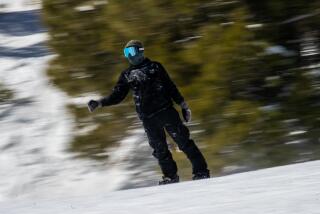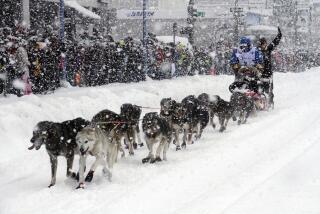Warm winters have cooled snowmobile sales
- Share via
MINNEAPOLIS — Here is an ironclad rule for selling snowmobiles: You need snow.
Warmer weather and thin snowfalls since the late 1990s have melted sales at Polaris Industries Inc. and Arctic Cat Inc., the only snowmobile makers in the U.S.
After one more wimpy winter in a long string of them, some dealers say they are struggling to clear out last year’s sleds, let alone sell out of this year’s. Some gave up months ago.
“When there was nothing here indicating that we were going to have a winter, by the first of October there was a business decision: Pull the cork,” said Dick Tschida, who sells sleds in Forest Lake, a suburb of Minneapolis.
Tschida returned more than 50 Arctic Cat snowmobiles and all-terrain vehicles and is switching to boats. The returns cost him about $7,000, but that’s a far cry from the $250,000 loss he figured he would take by the time he discounted them enough to sell.
A late-season storm that socked parts of the Northeast came far too late for dealers such as Tschida -- and for the snowmobile makers.
“The industry has been down for basically a decade straight,” analyst Edward Aaron of RBC Capital Markets said. This year was “probably the toughest of any of those years.”
Polaris snowmobile sales have dropped by more than half to $157 million last year from $373 million in 2001. Its 2006 profit fell 22% to $107 million on revenue of $1.7 billion.
Arctic Cat snowmobile sales have been more stable during the last five years but still dropped to $238 million during the company’s fiscal year that ended March 31, down more than 5% from the previous year, and profit was battered by incentives to move sleds off dealer floors.
For years, Polaris and Arctic Cat seemed like twins, synonymous with Minnesota’s snowy far north. The first Polaris snowmobile was built by Edgar Hetteen and some relatives at his derrick and hoist company in the mid-1950s.
He left what was by then Polaris Industries in 1960 and a year later started the company that became Arctic Cat at a time when dozens of fledgling snowmobile entrepreneurs were building snow vehicles with tracks in the back and skis in the front.
Its Thief River Falls, Minn., headquarters is only about 60 miles from Polaris’ main plant in Roseau. Yamaha Motor Co. of Japan and Bombardier Recreational Products Inc. of Canada also make snowmobiles.
But demand for the sleds has been shrinking. Worldwide snowmobile sales peaked at 260,000 sleds in 1997 and were expected to be about 160,000 this year, according to the International Snowmobile Manufacturers Assn.
The two U.S. companies have reacted in different ways.
Polaris added Victory motorcycles and has tried to strengthen sales of all-terrain vehicles to the military. It cut production of its 2007 snowmobiles by 40% to give dealers a shot at clearing out inventory. Last year snowmobiles accounted for less than 10% of Polaris sales.
Arctic Cat has stuck with the snowmobiles-in-the-winter and ATVs-in-the-summer formula, and snowmobiles remain about a third of its sales. Arctic Cat cut snowmobile production far less, about 4%. Another weak winter made that look like a mistake. Early this month, it announced plans to lay off 65 workers, and in January it cut its full-year profit forecast to $1.07 to $1.15 a share from $1.13 to $1.19.
A bright spot for both companies has been the growth of utility ATVs on which riders sit side by side -- think of a golf cart with a roll cage and off-road tires. Polaris added its Ranger ATV in 1998 and has said it believes that sales of a new, sportier version of the vehicle can add revenue of $150 million in the next three years. Arctic Cat added a side-by-side ATV in 2005.
Aaron of RBC Capital Markets said Polaris was also quicker to expand international sales.
“Arctic Cat is just starting to dabble with that,” he said. “Polaris has been faster and more aggressive in terms of its diversification.”
Another Polaris attempt at diversification didn’t work out. The company set up a partnership with Austrian dirt-bike maker KTM Powersports and said it expected to eventually buy all of KTM. Instead, KTM stayed independent, and Polaris has said it will sell most of its KTM shares this year.
Despite the snowmobile problems, Polaris said the sleds remained a key part of its business. President and Chief Operating Officer Bennett Morgan said the production cut last year meant the business was ready to grow again if the snow flew.
“We took some tough medicine. A lot of the other manufacturers chose not to,” Morgan said. “Surprising as it may seem, we feel much better about our snowmobile business today than we did in April.”
He said Polaris had never considered spinning off its snowmobile business despite the downturn in recent years.
Tschida says his days of selling snowmobiles are over. Too many people, he says, are hesitant to spend money on a toy they may not be able to use.
“They’re more apt to spend on a new aluminum boat to go fishing because they know they can go fishing from at least the first of May until the end of September,” Tschida said. “I can’t say that about four-wheeling or snowmobiles or any of the other winter sports.”
More to Read
Inside the business of entertainment
The Wide Shot brings you news, analysis and insights on everything from streaming wars to production — and what it all means for the future.
You may occasionally receive promotional content from the Los Angeles Times.










